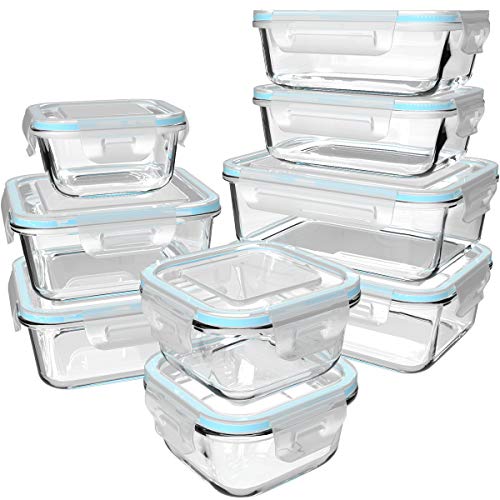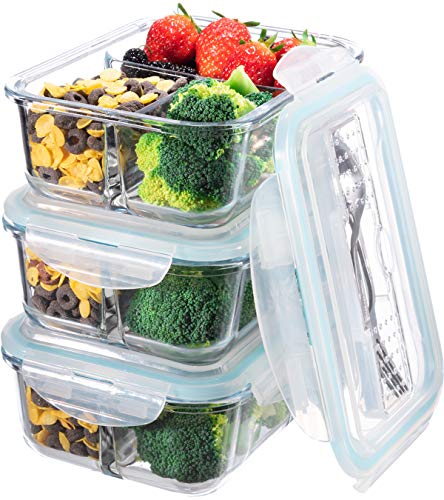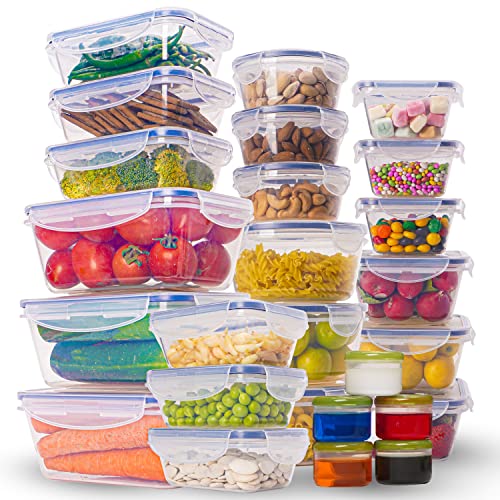If you’re someone who values good food, you know the importance of storing it properly. Whether you’re meal prepping, packing leftovers, or simply trying to keep your pantry organized, investing in the right food storage containers can make a big difference. But with so many options on the market, it can be overwhelming to know where to start. In this blog post, we’ll break down some of the most important factors to consider when choosing food storage containers. From plastic vs. glass to the benefits of airtight and leak-proof containers, we’ll help you make informed choices that will keep your food fresh and delicious for days (or even weeks) to come.
Table of Contents
The Importance Of Food Storage Containers
Food storage containers are crucial in keeping our food safe and fresh. They come in different sizes, shapes, materials, and features, making it a challenge to choose the best food storage containers that suit our needs. However, the importance of food storage containers cannot be overstated, as they play a significant role in reducing food waste, preventing contamination, and preserving the quality of our food.
One of the primary benefits of using food storage containers is that they help to reduce food waste. Airtight containers help to preserve the freshness of fruits, vegetables, and other perishables, preventing them from spoiling quickly. This means that you can buy in bulk and store them in the fridge or pantry without worrying about them going to waste. By reducing food waste, you can save money and contribute to reducing carbon emissions.
Plastic containers are the most common types of food storage containers. They are lightweight, shatter-resistant, and affordable. However, they are not suitable for heating food in the microwave and oven, as they may release harmful chemicals when exposed to high temperatures. On the other hand, glass containers are heavy, breakable, and expensive, but they are suitable for reheating food in the microwave and oven and are more eco-friendly than plastic containers.
In conclusion, food storage containers are essential for keeping our food fresh, reducing food waste, and preventing contamination. Whether you choose plastic or glass, airtight or leak-proof, stackable or meal prep containers, choosing the right food storage containers for your needs is important. By investing in quality containers that last, you can save money and contribute to a sustainable future.
Plastic Containers vs. Glass Containers: Which is Better?
When it comes to food storage containers, there are two popular options: plastic and glass. Both have their own pros and cons, making it difficult to determine which one is better. Some people prefer plastic containers, while others swear by glass. But which one is truly superior? Let’s take a closer look at the plastic containers vs. glass containers debate.
Plastic Food Storage Containers
Plastic containers are affordable, lightweight, and easy to handle. They come in a variety of shapes and sizes, making them versatile for all your food storage needs. Additionally, plastic containers are shatterproof, so there’s little risk of them breaking if dropped. However, plastic containers may contain harmful chemicals such as BPA, which can seep into your food and cause health problems. Therefore, it’s important to choose plastic containers that are labeled “BPA-free.”
Glass Food Storage Containers
Glass containers are more expensive than plastic containers, but they are also more durable and long-lasting. They are also a healthier option than plastic because they don’t contain harmful chemicals like BPA. Glass containers are also better at preserving the freshness of your food because they don’t absorb odors or stains like plastic does. However, glass containers are heavy, fragile, and can be dangerous if dropped. They are also more expensive to replace if they do break.
| Plastic Containers | Glass Containers |
|---|---|
| Affordable | Expensive |
| Lightweight | Heavy |
| Shatterproof | Fragile |
| May contain harmful chemicals | BPA-free and healthier |
| Can absorb odors and stains | Preserves freshness of food |
Ultimately, the decision between plastic containers vs. glass containers comes down to personal preference and needs. If you’re on a tight budget and need something lightweight and shatterproof, plastic may be the way to go. However, if you prioritize durability, health, and freshness, then glass is the better choice. It’s important to consider the pros and cons of each option before making a decision and investing in quality containers that last.
Airtight And Leak-Proof Containers: Why They Matter
When it comes to food storage containers, one of the most important factors to consider is whether or not they are airtight and leak-proof. Airtight containers help to keep your food fresh for longer, and leak-proof containers prevent messy spills and accidents. But why exactly do these qualities matter so much? Let’s take a closer look.
First and foremost, airtight containers provide an environment that is less conducive to bacterial growth. When food is exposed to air, it can begin to spoil more quickly. By sealing it in an airtight container, you can slow down this process and keep your food fresher for longer. This is particularly important for perishable items like meat, dairy, and produce.
Leak-proof containers, on the other hand, protect both your food and your other belongings. If you’ve ever had a container leak in your bag or fridge, you know how frustrating and messy it can be. Not only does it create a mess, but it can also lead to wasted food and even spoilage. By investing in leak-proof containers, you can avoid these issues and keep your food safe and secure.
| Best Airtight Containers: | Best Leak-Proof Containers: |
|---|---|
| – Glass storage jars with silicone seals – Plastic containers with snap-on lids – Vacuum-sealed bags with zip closures | – BPA-free plastic containers with locking lids – Stainless steel containers with silicone seals – Mason jars with screw-on lids |
Of course, not every container needs to be completely airtight or leak-proof. For example, you might not need an airtight container for a bag of chips or a box of cereal. However, for items that are more susceptible to spoilage or messes, investing in high-quality airtight and leak-proof containers is a smart choice.
Overall, the importance of airtight and leak-proof containers cannot be overstated. By keeping your food fresh and your belongings clean, these containers make meal prep and storage a breeze. Whether you prefer glass, plastic, silicone, or stainless steel, there are plenty of great options out there to suit your needs and preferences.
Stackable Containers: Making The Most Of Your Storage Space
Stackable containers are becoming increasingly popular for those who need to make the most of their limited storage space. These containers are designed to be stacked on top of each other, allowing for efficient use of vertical space. The stackable design also makes it easy to keep your food organized, as you can easily see what is inside each container without having to move things around.
- ✅FOOD STORAGE CONTAINER SET INCLUDES: 26 Containers with 26 Lids, 34 oz Rectangle Containers (3x),…
- ✅EASY TO CLEAN: Plastic food storage set with quick cleaning interior and exterior. A simple water…
- ✅STACK WELL: Kitchen stackable plastic food containers with airtight lids save space in kitchen…
- VARIETY WITH MORE CAPACITY: Large sized containers perfect for main course, 25 containers with 25…
- SPACE-SAVING STACKABLE DESIGN: These Apartment essentials for first Apartment & crystal-clear…
- LEAKPROOF AND OTHER BENEFITS: Our air tight food savers with 4 sides snap lock lids are microwave…
When it comes to choosing the best food storage containers for your needs, stackable containers are definitely worth considering. Not only do they save space, but they also help to keep your food fresh for longer. This is because the airtight seal created by stacking containers helps to prevent air and moisture from getting in, which can cause food to spoil more quickly.
| Pros: | Cons: |
|---|---|
| – Save space | – May be bulkier/heavier than other types of containers |
| – Keep food fresh for longer | – May not be as easy to see what’s inside without moving containers |
| – Help to keep your food organized | – May be more expensive than other types of containers |
One of the main advantages of stackable containers is that they are perfect for those who have limited storage space in their kitchen. By stacking containers on top of each other, you can make the most of your available space and keep your kitchen organized. This can be especially helpful if you have a small kitchen or if you live in an apartment with limited storage options.
Another benefit of stackable containers is that they help to keep your food fresh for longer. This is because the airtight seal created by stacking containers helps to prevent air and moisture from getting in. This can be particularly useful for foods that spoil easily, such as fruits and vegetables. Stackable containers can also help to keep your pantry items fresh, such as cereal and pasta.
Overall, stackable containers are an excellent choice for those who need to make the most of their limited storage space. They are designed to save space, keep your food fresh and organized, and are available in a variety of sizes and shapes to suit your needs. Whether you are meal prepping for the week or storing leftovers, stackable containers are a versatile and practical choice for all your food storage needs.
Meal Prep Containers: Keeping Your Food Fresh And Organized
Meal prepping has become increasingly popular in recent years, and for good reason. It allows you to save time and money by preparing your meals ahead of time, but it requires the right equipment to ensure your food stays fresh and organized. That’s where meal prep containers come in – they are essential for anyone looking to streamline their meal prep process.
When it comes to choosing the best meal prep containers, it’s important to consider a few factors. First and foremost, you want to make sure the containers are leak-proof and airtight to prevent any spills or spoilage. Stackable containers are also ideal for maximizing storage space in your fridge or freezer.
| Container Type | Pros | Cons |
|---|---|---|
| Plastic | Lightweight, affordable, and easily replaceable | May stain or retain odors over time |
| Glass | Durable, doesn’t stain or retain odors, and microwave-safe | Heavier, more expensive, and can break if not handled carefully |
Another consideration is the type of material – plastic or glass? Both have their pros and cons, so it ultimately comes down to personal preference. Plastic is lightweight and affordable, but it may stain or retain odors over time. Glass is more durable and doesn’t retain odors, but it can be heavier and more expensive.
Lastly, it’s important to choose the right size and shape for your needs. If you’re prepping meals for an entire week, larger containers may be necessary. If you tend to pack smaller, snack-sized portions, smaller containers may be more convenient. Whatever your needs may be, investing in quality containers that last will not only save you money in the long run but also ensure your food stays fresh and organized.
Alternative Food Storage Options: Silicone And Stainless Steel
Are you tired of using the same old plastic or glass food storage containers? Have you considered trying out alternative options like silicone or stainless steel? In this post, we’ll take a closer look at these two options and why they may be a better choice for your food storage needs.
Silicone Food Storage Containers
This material has gained popularity in recent years for its flexibility and durability. It’s heat-resistant, microwave-safe, and can go in the freezer or dishwasher without warping or cracking. Plus, it doesn’t contain any harmful chemicals like BPA or phthalates. Silicone containers typically come in bright colors and fun shapes, making them a fun and practical addition to your kitchen. However, some people may not like the texture or smell of silicone, so it’s important to do a smell and feel test before purchasing.
| Pros | Cons |
|---|---|
| -Flexible and durable -Can handle extreme temperatures -Dishwasher and microwave safe -No harmful chemicals | -May have a strong smell -Texture may be off-putting -Can stain with certain foods |
Stainless Steel Food Storage Containers
This material is a classic choice for food storage, known for its durability and longevity. Stainless steel containers won’t crack or chip like plastic or glass, and won’t retain any flavors or odors from previous meals. Plus, they’re dishwasher safe and recyclable. You can find stainless steel containers in a variety of shapes and sizes, from small snack containers to large meal prep containers. However, stainless steel can get hot to the touch when holding warm foods, and isn’t microwave-safe.
| Pros | Cons |
|---|---|
| -Durable and long-lasting -Recyclable -Doesn’t retain flavors or odors -Available in many sizes and shapes | -Can get hot to the touch -Not microwave-safe -May dent or scratch over time |
Overall, alternative food storage options like silicone and stainless steel may be a great choice for those looking for something different than the traditional plastic or glass containers. Consider your needs and preferences before making a purchase, and remember that quality and durability are key factors in finding the best food storage containers for your kitchen.
Choosing The Right Size And Shape For Your Needs
When it comes to storing food, it’s important to use the best Food Storage Containers to ensure it stays fresh and edible for longer. However, choosing the right container size and shape that suits your needs can be challenging. It’s essential to consider what food items you need to store and how much space you have available.
| Type of Container | Size and Shape | Best Food Items to Store |
|---|---|---|
| Rectangular containers | Long and narrow | Sandwiches, vegetables, and sliced fruits |
| Square containers | Equal length and width | Leftovers, pasta salads, and casseroles |
| Circular containers | Round or oval shape | Soups, stews, and curries |
Rectangular containers are ideal for storing sandwiches, vegetables, and sliced fruits. The shape makes it easier to stack containers and fit them into tight spaces. Square containers are perfect for storing leftovers, pasta salads, and casseroles. Their equal length and width make it easier for them to fit into your fridge or freezer. Lastly, circular containers are great for storing soups, stews, and curries. The round or oval shape helps to keep the food in the center and distributes heat evenly through the dish.
List:
- Consider your storage space and the size of your fridge before purchasing containers.
- Buy containers that stack neatly together to maximize your storage space.
- Choose containers that are easy to clean and dishwasher safe.
- It’s best to buy containers with snap-on lids to ensure an airtight seal.
- Always measure the height and width of your fridge shelves before buying containers to prevent any waste of container space.
Ultimately, the best Food Storage Containers for you will depend on your needs and personal preference. By considering the food items you need to store and the space available, you can make the right choice and maximize your storage space while keeping your food fresh and organized.
Durability And Longevity: Investing in Quality Containers That Last.
When it comes to food storage containers, many of us may settle for mediocre quality because we feel like they’re not that important, but they actually are. Investing in high quality food storage containers is not only smart for your wallet in the long run, but it’s good for the environment too. The best food storage containers are made of materials that are safe, durable, long-lasting, and can withstand everyday wear and tear.
Durability is a crucial factor when choosing a food storage container. Whether you’re putting it in the freezer or storing it in a pantry, you want to make sure that it’s able to withstand the test of time and won’t crack or break easily. Glass containers are known for their durability, and they’re also non-toxic and eco-friendly. Plastic containers are also durable but not all of them are safe for microwave or dishwasher use. It’s important to choose containers that can handle the temperature changes and won’t warp over time.
| Container Material | Durability | Longevity |
|---|---|---|
| Glass | High | Very high |
| Plastic | Medium-high | Medium |
| Silicone | Medium | Medium |
| Stainless Steel | High | Very high |
Longevity is another important factor to consider when investing in food storage containers. You want to choose containers that will last you a long time without deteriorating or getting damaged too easily. Glass containers are known for their longevity, and they’re also resistant to scratches and stains. Stainless steel containers are also a great choice if you’re looking for longevity, they’re tough, easy to clean, and also resistant to scratches and stains.
Investing in quality food storage containers is not only a smart financial decision, but it’s also a great way to reduce waste and help the environment by choosing materials that are recyclable and sturdy. When choosing food storage containers, it’s important to think about your needs and lifestyle, as well as the durability and longevity of the material. By choosing quality containers that can stand the test of time, you’ll be saving money in the long run, reducing waste, and keeping your food fresh and safe for consumption.
Frequently Asked Questions
Plastic containers are lightweight and less likely to break, while glass containers are more durable and non-toxic. Glass containers are also better for reheating food, as they don’t contain harmful chemicals like some plastics.
Airtight and leak-proof containers help to keep food fresh for longer and prevent spills or leaks, which can cause a mess and potentially contaminate other foods in the fridge or pantry.
Stackable containers can be easily organized and stored in small spaces, making it easier to find and access different foods. They can also help to prevent clutter and free up valuable counter or cupboard space.
Meal prep containers are specifically designed to help you plan and prepare healthy meals in advance. They typically have multiple compartments for storing different foods and can be easily transported to work or school.
Silicone and stainless steel are two alternatives to plastic and glass containers. Silicone is flexible, lightweight, and non-toxic, while stainless steel is durable and dishwasher safe.
Consider the amount of food you plan to store, as well as the available storage space. You may also want to choose containers that are easy to stack and organize, and that come with lids that fit securely.
Investing in quality containers can save you money in the long run, as they are less likely to break or wear out. Durable containers also help to keep your food safe and fresh, and can prevent food waste and contamination.

Hi, I’m Maria from Los Angles. Born and raised in a family of avid home cooks, developed a love for food at a young age. I remember spending weekends in the kitchen with her parents, learning how to make family favorites like lasagna and chocolate chip cookies. After graduating from college, started working as a marketing manager for a tech company, but I found myself spending all of her free time in the kitchen. Then I decided to share my experiences on FindForKitchen blog.












![C CREST [10 Pack] Glass Meal Prep Containers, Food Storage Containers with Lids Airtight, Glass Lunch Boxes, Microwave, Oven, Freezer and Dishwasher...](https://m.media-amazon.com/images/I/51KtYzS-grL.jpg)


![Freshware Meal Prep Containers [15 Pack] 1 Compartment Food Storage Containers with Lids, Bento Box, BPA Free, Stackable, Microwave/Dishwasher/Freezer...](https://m.media-amazon.com/images/I/515JcXk4mLL.jpg)


![[8 Pack] Salad Dressing Container To Go, 2.4oz Small Condiment Containers with Leakproof Silicone Lids, Reusable Stainless Steel Sauce Cups for Lunch...](https://m.media-amazon.com/images/I/41--7DmsKrL.jpg)

![TAVVA Stainless Steel Snack Containers for Kids [12oz/ 7oz/ 3oz] - Leakproof with Silicone Lids - Lunch Box for Kids - Metal Lunchbox for School,...](https://m.media-amazon.com/images/I/51HZDfwXsUL.jpg)